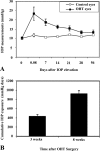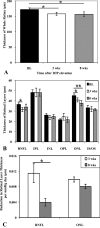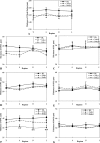Tracking longitudinal retinal changes in experimental ocular hypertension using the cSLO and spectral domain-OCT
- PMID: 20688741
- PMCID: PMC3055767
- DOI: 10.1167/iovs.10-5551
Tracking longitudinal retinal changes in experimental ocular hypertension using the cSLO and spectral domain-OCT
Abstract
Purpose: Involvement of the outer retina is controversial in glaucoma. The aim of this study was to test, first, whether the outer retina is affected in experimental ocular hypertension (OHT) and, second, whether whole retinal thickness can be used as a surrogate marker of glaucomatous change.
Methods: OHT was surgically induced in 20 Dark Agouti rats. Animals were imaged using a modified Spectralis OCT (Heidelberg Engineering, Heidelberg, Germany) at baseline and at 3 and 8 weeks after OHT induction. Measurements were recorded for whole and individual retinal layer thickness in four regions-temporal, superior, nasal, and inferior-around the optic nerve head.
Results: Whole retinal thickness in normal eyes was 172.19 ± 5.17 μm, with no significant regional differences. OHT caused a significant reduction in whole retinal thickness and the outer nuclear layer (ONL) at 3 and 8 weeks (P < 0.05), along with the expected thinning of the retinal nerve fiber layer (RNFL). Whole retinal thickness correlated well with RNFL (P = 0.035) and ONL (P ≤ 0.001) changes. Sensitivity of RNFL and ONL to IOP exposure appeared greater at 3 than at 8 weeks. In addition, regional profiles were significantly altered in the ONL and RNFL after OHT induction.
Conclusions: Adaptation of the Spectralis OCT enables tracking of structural damage in experimental rat OHT. Here the authors show evidence of glaucomatous damage in the outer retinal layers of this model with significant regional changes and highlight whole retinal thickness in the rat as a useful surrogate marker of inner and outer retinal changes. The authors believe that the OCT data can provide useful information with regard to clinical management.
Figures







Similar articles
-
Usefulness of optical coherence tomography parameters of the optic disc and the retinal nerve fiber layer to differentiate glaucomatous, ocular hypertensive, and normal eyes.J Glaucoma. 2007 Jan;16(1):1-8. doi: 10.1097/01.ijg.0000212215.12180.19. J Glaucoma. 2007. PMID: 17224742
-
Correlations Between the Individual Risk for Glaucoma and RNFL and Optic Disc Morphometrical Evaluations in Ocular Hypertensive Patients.J Glaucoma. 2016 May;25(5):e455-62. doi: 10.1097/IJG.0000000000000291. J Glaucoma. 2016. PMID: 26091177
-
Comparison of retinal nerve fiber layer imaging by spectral domain optical coherence tomography and scanning laser ophthalmoscopy.Ophthalmology. 2011 Nov;118(11):2196-202. doi: 10.1016/j.ophtha.2011.03.035. Epub 2011 Jul 16. Ophthalmology. 2011. PMID: 21762989
-
Comparison of retinal nerve fiber layer thickness values using Stratus Optical Coherence Tomography and Heidelberg Retina Tomograph-III.J Glaucoma. 2009 Sep;18(7):528-34. doi: 10.1097/IJG.0b013e318193c29f. J Glaucoma. 2009. PMID: 19745667
-
Comparison of confocal scanning laser ophthalmoscopy, scanning laser polarimetry and optical coherence tomography to discriminate ocular hypertension and glaucoma at an early stage.Graefes Arch Clin Exp Ophthalmol. 2006 Jan;244(1):58-68. doi: 10.1007/s00417-005-0029-0. Epub 2005 Jul 26. Graefes Arch Clin Exp Ophthalmol. 2006. PMID: 16044326
Cited by
-
Computer-Aided Diagnosis of Multiple Sclerosis Using a Support Vector Machine and Optical Coherence Tomography Features.Sensors (Basel). 2019 Dec 3;19(23):5323. doi: 10.3390/s19235323. Sensors (Basel). 2019. PMID: 31816925 Free PMC article.
-
Advances in retinal ganglion cell imaging.Eye (Lond). 2015 Oct;29(10):1260-9. doi: 10.1038/eye.2015.154. Epub 2015 Aug 21. Eye (Lond). 2015. PMID: 26293138 Free PMC article. Review.
-
Evaluation of retinal nerve fiber layer thickness and axonal transport 1 and 2 weeks after 8 hours of acute intraocular pressure elevation in rats.Invest Ophthalmol Vis Sci. 2014 Feb 4;55(2):674-87. doi: 10.1167/iovs.13-12811. Invest Ophthalmol Vis Sci. 2014. PMID: 24398096 Free PMC article.
-
Development of a rat schematic eye from in vivo biometry and the correction of lateral magnification in SD-OCT imaging.Invest Ophthalmol Vis Sci. 2013 Sep 27;54(9):6446-55. doi: 10.1167/iovs.13-12575. Invest Ophthalmol Vis Sci. 2013. PMID: 23989191 Free PMC article.
-
Tunable degrees of neurodegeneration in rats based on microsphere-induced models of chronic glaucoma.Sci Rep. 2022 Nov 30;12(1):20622. doi: 10.1038/s41598-022-24954-4. Sci Rep. 2022. PMID: 36450772 Free PMC article.
References
-
- Harwerth RS, Carter-Dawson L, Shen F, Smith EL, 3rd, Crawford ML. Ganglion cell losses underlying visual field defects from experimental glaucoma. Invest Ophthalmol Vis Sci. 1999;40:2242–2250 - PubMed
-
- Sommer A, Miller NR, Pollack I, Maumenee AE, George T. The nerve fiber layer in the diagnosis of glaucoma. Arch Ophthalmol. 1977;95:2149–2156 - PubMed
-
- van Velthoven ME, Verbraak FD, Yannuzzi LA, Rosen RB, Podoleanu AG, de Smet MD. Imaging the retina by en face optical coherence tomography. Retina. 2006;26:129–136 - PubMed
-
- Drexler W, Fujimoto JG. State-of-the-art retinal optical coherence tomography. Prog Retin Eye Res. 2008;27:45–88 - PubMed
Publication types
MeSH terms
Grants and funding
LinkOut - more resources
Full Text Sources
Other Literature Sources
Medical

